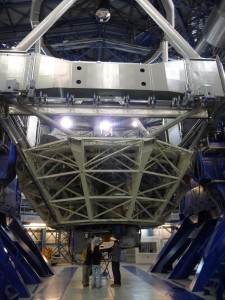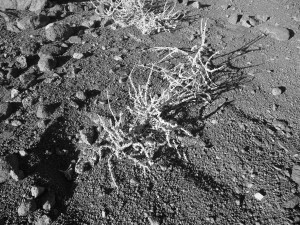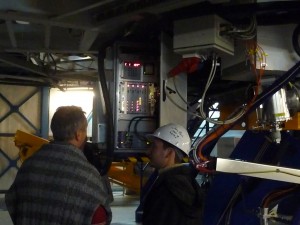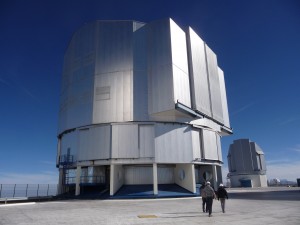X-Shooter goes on sky again (Day 0 and 1)

Light echo allows astronomers to type a 400 years old supernova
December 10, 2008
X-Shooter on sky again (Day 2)
January 17, 2009This and the posts that will follow in the next days is the report of the second Commissioning of the X-Shooter spectrograph, which has just started. I am now sitting in the control room of the VLT, in Cerro Paranal, Atacama desert, Chile. In itself, at least to me, this is already an extremely exciting fact. I hope I will be able to convey the feelings and the atmosphere we breath up here. It is just amazing…
X-Shooter is a new spectrograph that is going to be offered to the scientific community at the Very Large Telescope (VLT) of the European Organization for the Astronomical Research in the Southern Hemisphere (ESO). The instrument, which has been built by a consortium of European states, members of ESO, will feature very interesting capabilities, which make it the perfect instrument for objects like Gamma-Ray Bursts, Supernovae and other transient events. The most appealing property is the wide wavelength range, that ranges from the atmospheric cutoff (about 310nm) to the near Infrared (about 2.5 micron). X-Shooter is actually composed by three independent spectrographs, each of them optimized for three wavelength ranges: UV, Visual and Infrared. This has the advantage of producing a wide wavelength coverage with a high efficiency, which allows the scientists to get spectra of faint targets with a relatively high spectral resolution.

The UT3 Melipal telescope. The white structure is the main mirror cell. X-Shooter is just below it. The secondary mirror is also visible at the top of the photo.
X-Shooter has been assembled at the ESO Headquarters in Garching (Germany) and shipped to Chile in October 2008 and has been installed at the Cassegrain focus of the 8.2m VLT Telescope Unit 3, Melipal (the Southern Cross in the Mapuche language). In November 2008 the instrument has undergone a first testing run (which is usually called “commissioning”) during which its main functions have been tested and its scientific performance assessed. A second run was planned for the second half of January. And here we go.
The commissioning team is composed by Hans Dekker (ESO), Joel Vernet (ESO), Elena Mason (ESO), Paolo Santin (Trieste Observatory), Paolo Di Marcantonio (Trieste Observatory) and myself (ESO). The adventure started on Monday, when we left Europe around 16. After a never ending trip, that has lasted about 36 hours, we have reached the top of Cerro Paranal, about 1200 km north of Santiago de Chile, about 120 km south of the harbor city of Antofagasta.

Paranal, Atacama desert, is a very dry place. Yet, some brave vegetation survives the extreme conditions.
The site is breathtaking, no matter how many times you have seen it. I will keep adding some pictures that, I am sure, will give you only a pale idea of what the place looks like in reality. Nature in itself is stunning, but the presence of these giant telescopes makes it even more astounding. The night sky is simply beautiful and I do not find words to describe it. You just need to see it with your own eyes. In the next days I’ll try to convey to you what we see from here.
After a first night (completely black, with no dreams), yesterday we have started the first activities, bringing back to life the instrument, that has been resting for the last two months. I am an astronomer, so I do not have very much experience with technical stuff and I am a bit intimidated by the complexity of the hardware. But Hans and Joel are in their natural habitat and with the help of the two Paolos, who are the instrument software gurus of the team, have managed to awake the machine from its sleep. They keep talking about electronic boards, encoders, cross-dispersers, temperature sensors and telecentric optics. I am not sure I get all what they are saying, but it looks like things are going well. I like this very friendly atmosphere and the patience they have in answering my questions and satisfying my genuine curiosity.
Sometimes I can’t believe this is all true. When I started getting interested in astronomy, carrying my home-made telescope on the hilltops of north-eastern Italy, I could have never imagined one day I would be walking on the platform of one of the biggest telescopes of the world, sitting in its control room, and eventually using it for my own scientific research…

One of the X-Shooter electronics racks. Joel Vernet and Paolo Di Marcatonio under the main mirror cell.
The whole morning and part of the afternoon is spent running tests on the various functions of the instruments. The plan is to get ready for tomorrow, when we will go back on sky. Tonight the telescope is used by the VLT Interferometer and so we still have some time to rest, before we enter what I consider the most exciting part of the mission.
After dinner, at the residencia, I could not resist and I went up to the control room, where the four giant telescopes are operated. My good old friend Giovanni Carraro, staff astronomer at the Paranal Observatory, is working at UT4. The original idea was to stay up with him most of the night, in order to get into the night shift for the upcoming days. But at midnight I simply felt exhausted and I decided to go to sleep.
Down at the base camp, before entering the residencia, I watched the sky for some time. “Wait for me” – I thought – “I’ll come back tomorrow”.
P.S. I am writing these notes during the nights at the telescope. So, please, forgive any possible typos and improper usage of the English language.



1 Comment
I recently came across your blog and have been reading along. I thought I would leave my first comment. I don’t know what to say except that I have enjoyed reading. Nice blog. I will keep visiting this blog very often.
Joannah
http://linuxmemory.net